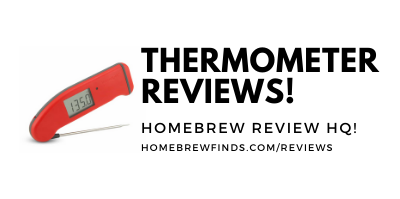
Hands on Review: ThermoWorks ProNeedle Thermometer!
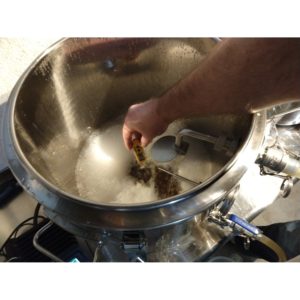
This review is by Homebrew Finds Contributor Brad Probert. Brad is an engineer, expert homebrewer and experienced reviewer. Grab a link to Brad’s website at the end of this review.
Thermoworks ProNeedle
Beer brewing combines your artsy side (recipe creation) with your nerdy side (brewing process discipline). One thing your nerdy side can’t be without is temperature data. Whether it’s mash temperature or fermentation temperature, a few degrees difference can change your results. And to get repeatable results, you need to control your brewing process so you can hit the same temperatures again next time.
Thermoworks specializes in temperature sensors of all shapes and sizes. They were founded in 1997 and serve multiple industries that require temperature monitoring. Specifically well suited for homebrewing, they have quick-responding and accurate digital thermometers that are waterproof rated.
The ProNeedle has an accuracy of +/- 0.9 degrees F within the temperature band of 14F – 212F. It works at temperatures outside that band, but the accuracy drops off significantly. The digital display reads out in tenths of a degree. The thermometer senses when you rotate it, and the digital readout is able to flip 180 degrees to try to keep it readable. There’s a button you can push to backlight the LED in low light situations. It also has a min/max function, such that when finishing measuring something, you can pull up the maximum temperature read and minimum temperature read by cycling through it with a button push.
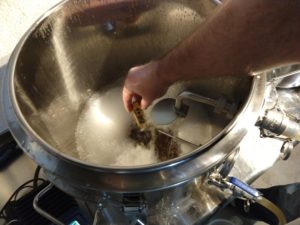 Measuring Mash Temperature
Measuring Mash Temperature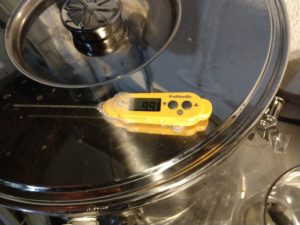 Confirming Mash Temp Using Max Function
Confirming Mash Temp Using Max Function
You might be concerned about electronics up close to your wort since the things you try to keep dry somehow are the first bits to get splashed. The ProNeedle is certified to IP67 standard (can handle up to 30 minutes submerged to a 39” depth), so you don’t have to worry when it gets splashed, or even if you lose your grip and have to fish it out of the mash tun. The thermometer is designed to fit in your pocket, so it’s about the length of a pen. Half of that length is the electronics body with the buttons and screen, and the other half is the thin stainless probe. The probe is 2.9” long, but only needs to be submerged at least 1/4″ to get a temperature reading. It comes with a plastic cover to protect the probe when not in use (and also to protect you from the pointy end of the narrow probe).
It uses a small CR1632 battery, which is good for 3,000 hours (without backlight) of temperature measurements. If you forget to push the power button to turn it off, it has an auto-off feature that will shut it off after several minutes. Thermoworks stands behind the thermometer with a 5-year warranty, as well.
Get Current Pricing + Related, Review Continues Below
- ProNeedle™ – The Ultimate Pocket Digital Thermometer
- Grab a spare battery: CR1632 Battery via ThermoWorks – Search Amazon for “CR1632 battery”
- Thermoworks Thermapen® Mk4 – Hands on Review
- Classic Super-Fast® Thermapen – Hands Review
- Save 10% on ThermoWorks Purchases!
- ThermoWorks & Thermapen – Deals, Discounts and Coupons!
Unboxing ThermoWorks ProNeedle Thermometer
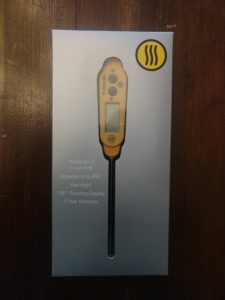 ProNeedle in the Box
ProNeedle in the Box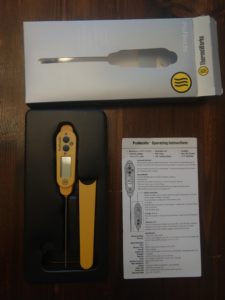 Unpacking the Box
Unpacking the Box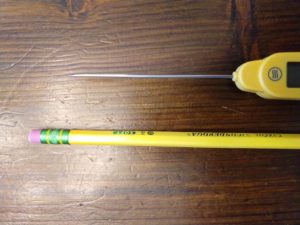 Probe Thickness Compared to Pencil
Probe Thickness Compared to Pencil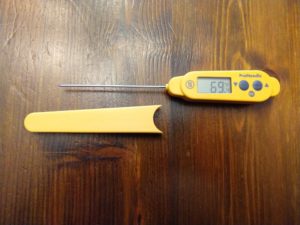 Thermometer and Protective Case
Thermometer and Protective Case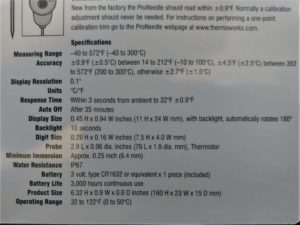 ProNeedle Specifications
ProNeedle Specifications
ProNeedle Hands on Review
Unpackaging the ProNeedle, the quality of materials/design were readily apparent. The body was made of a durable plastic with a texture to keep it from being slippery when wet, and a nice cheery yellow color. The digital readout was small (about 1/2″ x 1”), but really maximized to be as big as the compact size would allow. It was definitely a convenient size for throwing in a shirt or pants pocket when not in use.
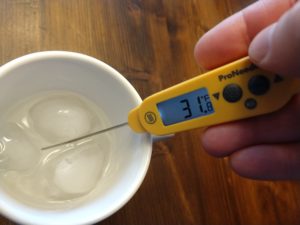 Checking Calibration in Ice Bath
Checking Calibration in Ice Bath
To spot check the accuracy, I made a simple ice bath in a coffee mug and confirmed it was reading within the prescribed accuracy (clocked in at 31.8 F). I then moved on and used the ProNeedle in a few different brewing scenarios. The first was during a mash process, where the backlight was really needed to be able to read the small numbers. This was very nice, after dealing with my old digital thermometer that required a flashlight to read in similar conditions. The decimal place digit of the temperature (to the tenths of a degree) was a bit hard to read, crowded in at the very end of the display. However, the max/min button function came in super handy for this. I could focus on putting the thermometer in the spot I wanted to measure, then I could pull it out and press the max/min button to get the peak temperature read.
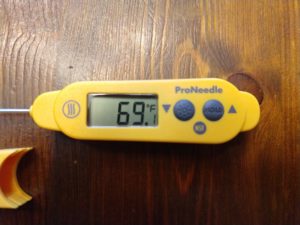 Close up of Display and Front Buttons
Close up of Display and Front Buttons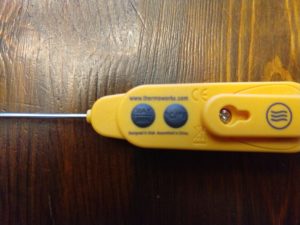 Close up of Buttons on Back
Close up of Buttons on Back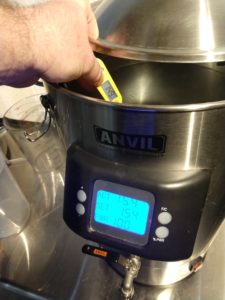 Comparing Strike Water Temp without Circulating
Comparing Strike Water Temp without Circulating
The temperature response was quick. Notably faster than the digital thermometer I had been using. I had always thought it was a direct trade-off between response time and accuracy, but the ProNeedle showed that wasn’t the case. My old thermometer had a temperature accuracy of +/- 2F and took 15-20 seconds to stabilize. The ProNeedle had +/- 0.7F accuracy and took 4-5 seconds to stabilize on its final temperature going from cool basement air temperature (63F) to a fermentation temperature (73F) or to a near mash temperature (130F). So comparing to my old thermometer, the ProNeedle had the best of both worlds- better accuracy AND faster response.
Most of my brewing equipment now has its own temperature sensor- digital mash controller, digital fermentation temp controller, and Tilt hydrometer. But it’s still nice to have a quick-responding thermometer to do spot checks on temperature. The main use I have for a handheld thermometer now is for calibrating all of these devices.
Being a frequent reader of homebrewing forums, I typically collect anecdotes from other brewers on their experiences with fermentation temperatures with different yeast strains. So when I set my fermentation temperature target, I want to have confidence it’s actually controlling to that temperature so I can compare my results to those that I’ve read. The standard for thermometers is to check the calibration at 32F in an ice bath or 212F boiling water (Michigan is at sea level). But the Tilt’s operating range has a minimum of 38F, and the fermentation temperatures I want to be accurate are in the 50 – 75F range. Using the ProNeedle as my temperature data “master gauge”, I made some 1 gallon water baths in this fermentation temperature range. I then entered temperature corrections into my Tilt app to match the thermometer and did the same with my fermentation controller temperature sensors. Now I know they’ll be tracking together!
Conclusions
The ProNeedle is nicely made of high-quality materials and craftsmanship, and comes in a conveniently compact size. The features are of good quality with the rotating display, min/max temperature button, and backlit readout. And the performance capability makes it a great match for homebrewing- fast response time, temperature accuracy, and waterproof rating. Finding all of this at a price just above $30, is quite surprising.
Get Current Pricing + Related
- ProNeedle™ – The Ultimate Pocket Digital Thermometer
- Grab a spare battery: CR1632 Battery via ThermoWorks – Search Amazon for “CR1632 battery”
- Thermoworks Thermapen® Mk4 – Hands on Review
- Classic Super-Fast® Thermapen – Hands Review
- Save 10% on ThermoWorks Purchases!
- ThermoWorks & Thermapen – Deals, Discounts and Coupons!
More Photos
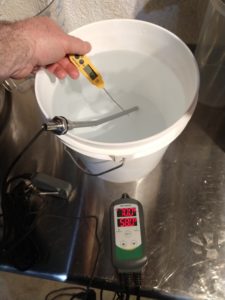 Calibrating Inkbird Temp Controller – Hands on Review
Calibrating Inkbird Temp Controller – Hands on Review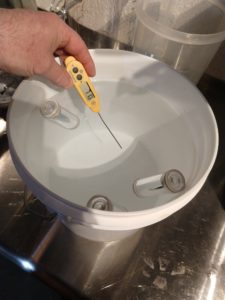 Checking Tilt Temperature Calibration – TILT Hands on Review
Checking Tilt Temperature Calibration – TILT Hands on Review
More Homebrew Finds!
- Last 50 Finds!
- Top Deals – a curated list of the best deals
- Homebrew Reviews – one of the largest libraries of homebrew reviews in existence!
- Our Top Posts – tips, how-tos, resources posts and more
- Let’s be Friends!
This post may contain affiliate links. We may make a commission when you use our links. This will never cost you extra. Thank you for supporting Homebrew Finds!
greatdealsSpecial thanks to ThermoWorks for providing the units used for evaluation in this review.
By Brad Probert. Check out Brad’s website – beersnobby.com
Make sure the components you use are compatible and rated for your intended application. Contact manufacturer with questions about suitability or a specific application. Always read and follow manufacturer directions. review:proneedle tag:tpr

